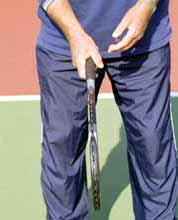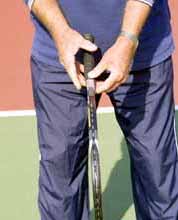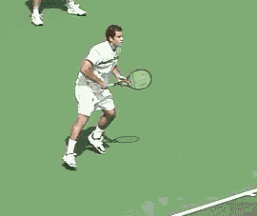The Lansdorp Forehand
By Robert Lansdorp
The Grip
The foundation of the forehand is the grip. One of the biggest problems in American junior tennis is the poor foundation so many young players have because of their extreme grips.
Under the handle, extreme western grips are incredibly common in high level junior tennis. Kids have great success early in their careers because they can hit topspin and get a lot of balls in play. If the ball is high and not too fast, these kids actually look pretty good.
|
The limitations don't show up until later, in the older age divisions or when a good young player first tests himself in professional tennis. Now these same kids suddenly don't look so great. They have severe problems handling the pace in the pro game, especially when the ball is low and skidding.
But nobody talks about these problems. Kids hold the rackets with the extreme grip and think it's alright. Nobody stands up and says that teaching extreme western grips are actually ruining these kids.
Nobody explains to the parents that if you take your 8-year old to a coach who let's the kid hit with an extreme grip, you're already up the creek - you just won't know it for another 8 years. This is what I call the disaster of teaching methods in American junior tennis.
The great players in the history of the game (with very few exceptions) have always had the ability to hit through the ball - to drive the ball with topspin and to handle great pace.
Classical grips, the grips I taught players like Tracy Austin, Pete Sampras, and Lindsay Davenport, allow young players to handle the ball when it is hit hard and is skidding.
 |
 |
 |
Eastern or Classic: The classic eastern grip shown with the hand closed and open. With the hand open, you can see how the grip places most of the palm behind the handle. The classic followthrough with this grip insures the player hits through the ball. This is the foundation for building the forehand |
If another coach had gotten hold of Lindsay Davenport and started her with an extreme grip, Lindsay
would not be where she is now. She would not be able to put the ball away like she does.
Of course if a kid is very talented he can have success with western grips, but it
makes it so much more difficult. People point to Juan Carlos Ferraro. They argue that he's got an
extreme grip and he's in the top 10 in the world. Maybe Ferraro is so strong he can put the ball
away with his forehand, but it takes so much effort. How good would he be if he had learned to hit
through the ball with a more classical grip?
There is no way to answer questions like these, but I wonder if some players who were
close to the top - players like Jim Courier for example - might have had even more success if they had
been given better basic foundations.
In this article I want to share my thoughts about how to build the foundation with the
right grips. I also want to explain the critical relationship between the grip and the followthrough,
something else that is rarely discussed in junior coaching.
 |
 |
 |
Semi Western:After a young player has developed the ability to hit the ball, it's acceptable for his grip to slide slightly toward a western grip to develop more topspin, as shown here. Note the difference in the followthrough compared to the classic grip above. |
The Followthrough
The followthrough is absolutely critical in developing the proper foundation. If the followthrough is in the right place, then you know the kid hit
through the ball. This is something that is easy to see if you know what to look for.
I look at the beginning of the stroke, how the kid holds the racket, and I look at the end of the stroke, the followthrough.
If the beginning is perfect and the end is perfect, I can guarantee the hit through the ball was perfect too.
If you are a parent or a coach you should do the same. The photos demonstrate the four most common grips and the
followthroughs they produce. From this any player or coach can recognize whether a player has a solid foundation, or if the grip is
too extreme.
Look at how the player holds the racket, then ask him to open his hand. This will show you the exact position of the
hand on the racket handle.
 |
| Hit through the ball: The racquet stays behind the ball and moves through the line of the shot before moving upward. |
Watch the followthrough as he hits. You'll see the way the stroke finishes
correlates with how the player holds the racket.
When I start young players, I treat them all as if they can become champions.
I'm teaching them the grips that give them the foundation to become as good as they possibly can,
maybe even a world champion.
Over the years, people who watched junior tennis would say they could tell which players were taking from me.
It was obvious the way they hit through the ball.





